Morphosyntactic Analysis on English Inflectional Affixes with Special Reference to The Jakarta Post
on
DOI: 10.24843/JH.2018.v22.i03.p27
ISSN: 2302-920X
Jurnal Humanis, Fakultas Ilmu Budaya Unud
Vol 22.3 Agustus 2018: 751-757
Morphosyntactic Analysis on English Inflectional Affixes with Special Reference to The Jakarta Post
Koming Tri Widari
English Department, Faculty of Arts – Udayana University [komingtriwidari14@gmail.com]
Abstract
This study is entitled Morphosyntactic Analysis on English Inflectional Affixes with Special Reference to The Jakarta Post. It is aimed at finding out the types of inflectional affixes and explaining how the inflected words found in The Jakarta Post are represented in tree diagram. The data of this study were taken from 31 articles related to business in The Jakarta Post printed edition published on 14th, 15th, and 16th of June 2017. Observation method was applied in this study for collecting data. Firstly, Articles about business were chosen. Secondly, the articles were read intensively one by one in order to find out the affixes occurring on the articles. Thirdly, every affix was marked and noted down. Lastly, those affixes were classified into inflectional affixes. The data were analyzed descriptively based on the theories of inflectional affixes proposed by Francis Katamba (1993) in his book entitled Morphology as the main theory and the theory of tree diagram by Quirk at al. (1985) in his book entitled A Comprehensive Grammar of the English Language presented as supporting theory. Based on the analysis, suffixes found in the articles are the suffix –s in noun, the suffix –s in verb, the suffix –ed, the suffix –ing, the suffix –er, and the suffix –est.The suffix –s in noun and suffix –ed are the most frequent types that appearing in the data. The finding also shows that there are five syntactic functions found in the data; they are subject, predicate, object, complement, and adverbial. The inflected word as predicate appears more frequently than the other syntactic functions.
Keywords: morphosyntax, inflectional affixes, The Jakarta Post.
Abstrak
Penelitian ini berjudul Morphosyntactic Analysis on English Inflectional Affixes with Special Reference to The Jakarta Post. Tujuan dari penelitian ini adalah untuk menemukan tipe-tipe imbuhan infleksi dalam bahasa Inggris, dan untuk menjelaskan bagaimana kata-kata infleksi yang di temukan di The Jakarta Post dalam bentuk diagram pohon. Data dari penelitian ini diambil dari 31 artikel tentang bisnis di The Jakarta Post edisi cetak yang terbit pada tanggal 14, 15, dan 16 Juni 2017. Metode observasi diterapkan dalam penelitian ini untuk mengumpulkan data. Pertama, artikel tentang bisnis dipilih. Kedua, artikel dibaca secara intensif satu per satu untuk mengetahui imbuhan yang muncul pada artikel. Ketiga, setiap imbuhan yang ditemukan ditandai dan dicatat. Terakhir, imbuhan tersebut dikelompokkan menjadi imbuhan infleksi. Data dianalisis secara deskriptif berdasarkan teori imbuhan infleksi yang dikemukakan oleh Francis Katamba (1993) dalam bukunya yang berjudul Morphology sebagai teori utama, dan teori diagram pohon oleh Quirk at al (1985) dalam bukunya
yang berjudul A Comprehensive Grammar of the English Language disajikan sebagai teori pendukung. Berdasarkan analisis, akhiran yang ditemukan dalam artikel adalah akhiran –s dalam kata benda, akhiran –s dalam kata kerja, akhiran –ed, akhiran –ing, sufiks -er, dan akhiran –est. Akhiran –s dalam kata benda dan sufiks –ed adalah jenis akhiran yang paling sering muncul dalam data. Hasil penelitian juga menunjukkan bahwa ada lima fungsi sintaksis yang ditemukan dalam data yaitu, subjek, predikat, objek, komplemen, dan adverbial. Kata infleksi sebagai predikat muncul lebih sering daripada fungsi sintaksis lainnya.
Kata kunci: morposintaksis, imbuhan, The Jakarta Post
Linguistics has four branches of study; they are phonology, semantics, morphology and syntax. In learning language it needs to be concerned with words and their functions in a sentence. There are four word classes that have different functions; they are verbs, nouns, adjectives and adverbs. In morphology, by adding an affix to a word it can either change the meaning or class of a word or modify a form of a word so that it can fit into a particular syntactic slot. However, people sometimes still get confused about the meaning or class of a word when its form is changing. Here, the study of Morphology and Syntax are related to the phenomena mentioned above.
According to Katamba (1993), Morphology is the study of the internal structure of words. How they are formed and related to other words in the same language. Syntax, unlike such components as phonetics or phonology, semantics, and pragmatics, is a system that is purely internal to language (Falk, 2001: 1). Both of the studies can be combined into what is called as Morphosyntax.
According to Katamba (1993) a morpheme is the smallest grammatical unit in a language that is meaningful. An affix is a morpheme that can be attached to a base or root to form a new word or a new form of a word. Inflectional affix is required to make a sentence grammatically correct, but they add little
meaning to the word. They never change grammatical class of a word, but each grammatical class has its own special set of inflectional affix.
Based on the background above, it is very interesting to analyze and find out the types and functions of inflectional affixes in English when they are attached to a root, stem, or base. There are some previous studies about inflectional affixes. However, they only focus on morphological aspect. This study provides the useful information to the readers to enlarge their understanding of the types and functions of inflectional affixes morphologically and syntactically in order to help them make good sentences and understand the meaning of the sentences.
The problems that rise based on the background stated are:
-
a. What are the types of inflectional affixes found in The Jakarta Post?
-
b. How are the inflected words found in The Jakarta Post represented in tree diagram?
From the question above, the aims of this study are:
-
a. To find out the types of inflectional affixes found in The Jakarta Post.
-
b. To explain how the inflected words found in The Jakarta Post are represented in tree diagram.
In research and scientific writing, a method becomes an important aspect. The research method in this study deals with four sections; they are; data source, method and technique of collecting data, method and technique of analyzing data, and method and technique of presenting analysis. Each of those sections is presented in detail below.
The data of this study were taken from thirty one articles related to business in The Jakarta Post printed edition published on 14th, 15th, and 16th of June 2017. The Jakarta Post is one of the famous daily English language newspapers established in 1983. Articles related to business were chosen because in this global era, information about both national and international business conditions are really needed to be known by the readers. The Jakarta Post was chosen as the data source because many inflectional suffixes related to this study could be found.
Observation method was applied in this study for collecting data. The data were collected through the following steps:
-
a. Articles about business in The Jakarta Post were chosen.
-
b. The articles were read intensively one by one in order to find out the affixes occurred on the articles.
-
c. Every affix found in the articles was marked and noted down.
-
d. Those affixes were classified into inflectional affixes.
The collected data were analyzed descriptively by applying the theory
proposed by Katamba (1993) and Quirk et al (1985). There are some steps in analyzing the data, they are;
-
a. The collected data were organized into a list to make them easier to be analyzed. The data with the same stem or base were written only once.
-
b. The words were separated from their affixes to know the base and the morphological process. This was done in order to find out what the types of inflectional affixes were found in the data.
-
c. The data were analyzed to find out the syntactic structure of the words using tree diagram.
In this study, formal and informal methods were used in presenting the analysis. In formal method, each data was presented using tree diagram. Meanwhile, in informal method, each data in this study was presented descriptively by words and explanation. Therefore, the analysis can be described in detail.
There are two main focuses discussed in this study, they are; the types of inflectional affixes occurring in the data and how the inflected words were represented in tree diagram, by using the main theory proposed by Katamba (1993) and theory of tree diagram found in a book proposed by Quirk et al (1985). The data in this study were taken from the articles about business published in The Jakarta Post.
Katamba gives a theory that English has no inflectional prefix but some other languages do (1993: 51). In English there are six inflectional affixes that are frequently used; they are the
suffix –s (in noun and in verb), the suffix –ed, the suffix –ing, the suffix –er, and the suffix –est.
There are 32 oil fields.
The base of the word fields is field. It is a noun and according to Oxford Advanced Learner’s Dictionary, its meaning is an area of land in the country used for growing crops or keeping animals in, usually surrounded by a fence. The attachment of the suffix – s does not change the word class and the meaning of the word. The suffix –s attached to the word as marker of plural noun. Therefore, the word fields indicates that there are more than one field.
The government appears confident
The base of the word appears is appear. It is a verb and according to Oxford Advanced Learner’s Dictionary, its meaning is to give the impression of being or doing something. The attachment of suffix –s does not change the word class and the meaning of the word. The suffix –s is attached to the word as marker of singular pronoun and simple present tense. Therefore, the word appears indicates the activity happening in the present time with singular pronoun.
Economists predicted the neutral policy
The base of the word predicted is predict. It is a verb and its meaning is to say that something will happen in the future. The attachment of suffix –ed does not change the word class and the meaning of the word. The suffix –ed attached to the word is the marker of simple past tense. Therefore, the word predicted indicates the activity happening in the past time.
It is launching new sales channels
The base of the word launching is launch. It is a verb and according to Oxford Advanced Learner’s Dictionary, its meaning is to make a product available to the public for the first time. The attachment of suffix –ing does not change the word class and the meaning of the word. The suffix –ing attached to the word is the marker of progressive data. Therefore, the word launching indicates that the activity is in progress.
Banks can issue bonds with lower interest rate
The base of the word lower is low. It is an adjective and according to Oxford Advanced Learner’s Dictionary, its meaning is below the usual or average amount. The attachment of suffix –er does not change the word class and the meaning of the word. The suffix –er attached to the word is the marker of comparative degree, which has positive degree low.
The latest data from the tax authority
The base of the word latest is late. It is an adjective and according to Oxford Advanced Learner’s Dictionary, its meaning is near the end of a period of time, a person’s life, etc. The attachment of suffix –est does not change the word class and the meaning of the word. The suffix –est attached to the word is the marker of superlative degree, which has positive degree late.
A tree diagram is more informative if it labels the constituents as instances of particular units or classes of units as stated by Quirk (1985: 39) and it is easier to read and to be understood than the
other ways. Therefore, this theory helps determine the positions of the inflected words in clauses.
There are 32 oil fields
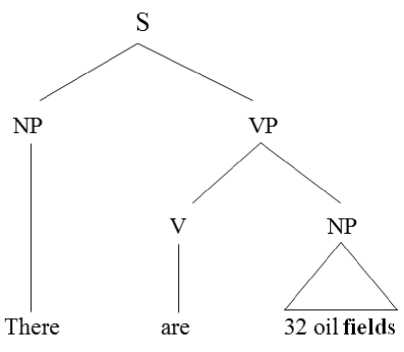
In the sentence above the word fields is a part of object. The word fields has position as noun with noun phrase 32 oil as the pre-modifier. The noun phrase 32 oil fields consists of the noun fields as the head of the phrase and noun phrase 32 oil as the pre-modifier.
The government appears confident

In the sentence above the word appears is a part of predicate. The word appears has position as verb. The verb
phrase appears contains a verb appears as the main verb.
5.2.3 Suffix –ed
Economists predicted the neutral policy
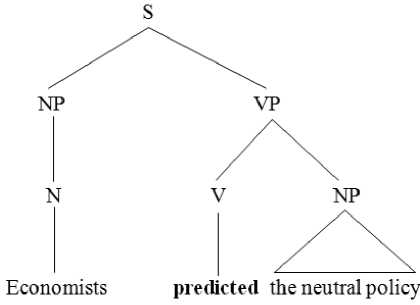
In the sentence above, the word predicted is a part of predicate. The word predicted has position as verb. The verb phrase predicted contains the verb predicted as the main verb.
5.2.4 Suffix –ing
It is launching new sales channels
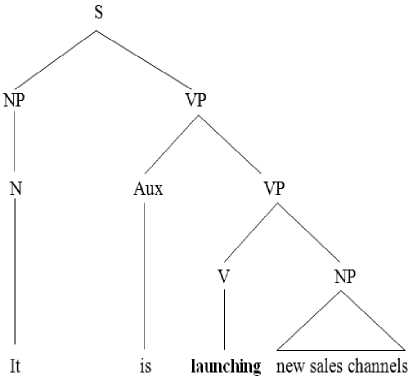
In the sentence above the word launching is a part of predicate. The word launching has position as verb with the auxiliary is as the pre-modifier. The verb phrase is launching consists of the verb launching as the head of the phrase and auxiliary is modifies the head as premodifier.
Banks can issue bonds with lower
interest rate
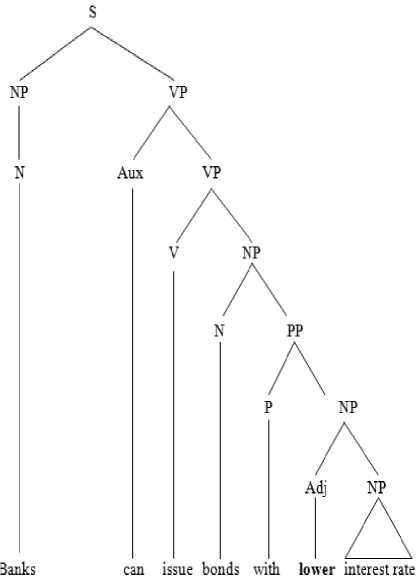
In the sentence above, the word lower is a part of complement. The word lower has position as adjective and it modifies the noun phrase interest rate which is the head of the phrase. The noun phrase lower interest rate consists of the adjective lower as the pre-modifier of the phrase and the noun phrase interest rate as the head of the phrase.
5.2.6 Suffix –est
The latest data from the tax authority
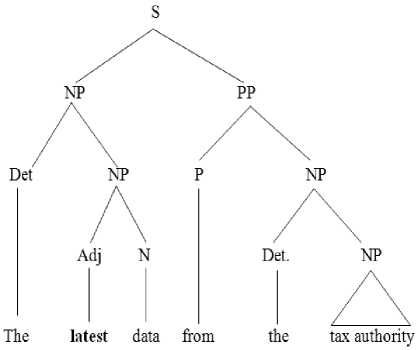
In the sentence above, the word latest is a part of subject. The word latest has position as adjective and it modifies the noun data which is the head of the phrase. The noun phrase latest data consists of the adjective latest as the premodifier of the phrase and the noun data as the head of the phrase.
Based on the analysis, all types of inflectional suffixes found in 31 articles about business published by The Jakarta Post; they are suffix –s in noun, suffix –s in verb, suffix –ed, suffix –ing, suffix – er, and suffix –est. Suffix –s in noun and suffix –ed are the most frequent types that appear in the data.
Tree diagram has been used in order to find the syntactic function of the inflected words. There are five syntactic functions of inflected words found in the data, they are subject, predicate, object, complement and adverbial. The inflected word as predicate appears very frequently than the other syntactic functions.
Bauer, Laurie. (1983). English Word-Formation. Cambridge University Press, Cambridge.
Falk, Yehuda N. (2001). Lexical-Functional Grammar: An Introduction to Parallel Constraint-Based Syntax. CSLI Publications, Stanford.
Hornby, A.S. (2010). Oxford Advanced Learner’s Dictionary. Oxford University Press Inc, New York.
Katamba, Francis. (1993). Morphology. Macmillan Press, London.
Quirk, Randolph and Sydney Greenbaum. (1973). A University Grammar of English. Longman, London.
Quirk, Randolph et al. (1985). A Comprehensive Grammar of the English Language. Longman, New York.
Swan, Michael. (1980). Practical English Usage. Oxford University Press, Hongkong.
Thomson, A.J. and Martinet, A.V. (1986). Practical English Grammar. Oxford University Press, London.
757
Discussion and feedback